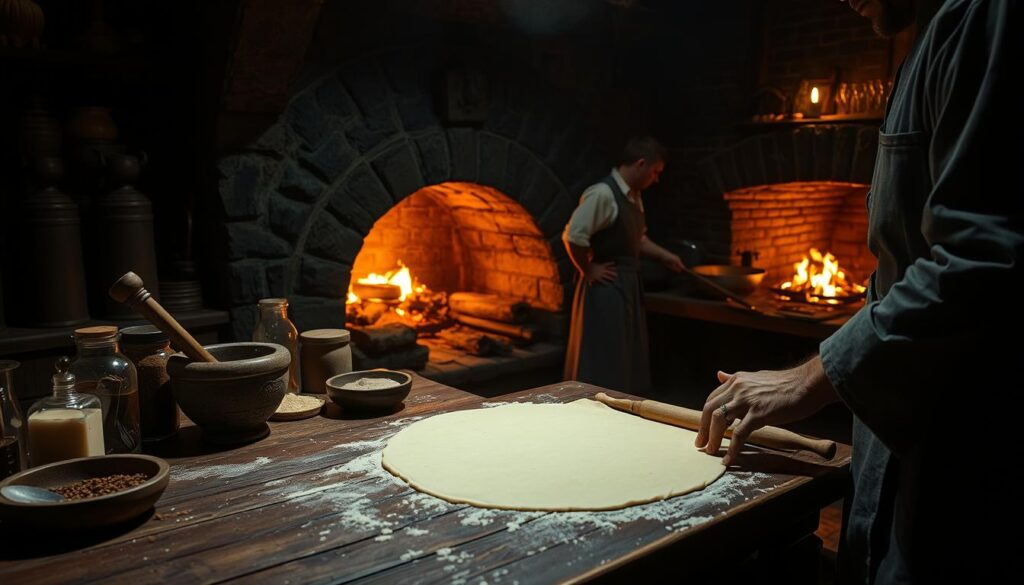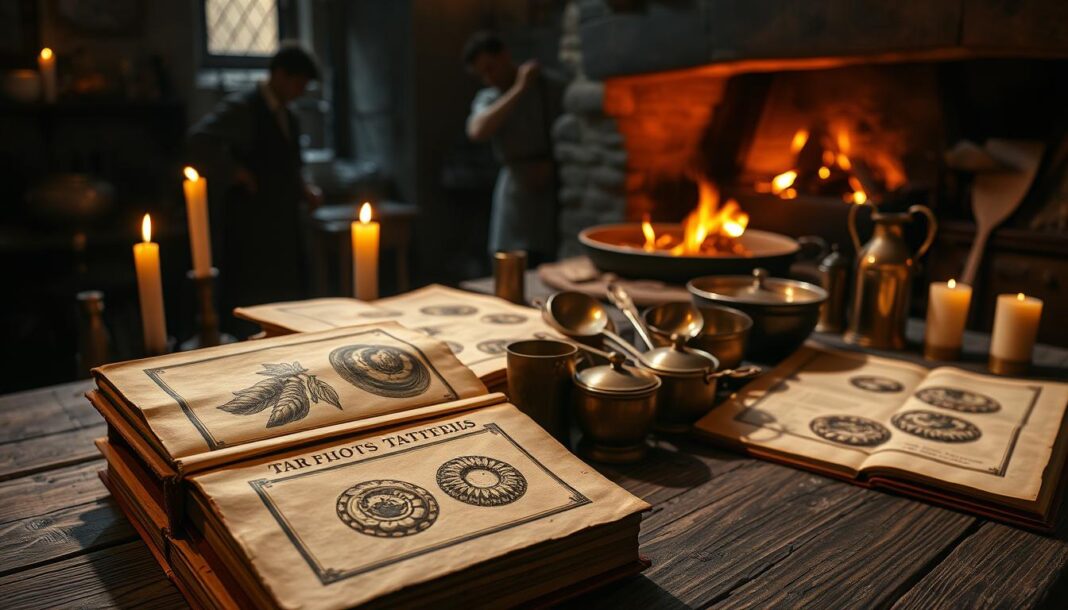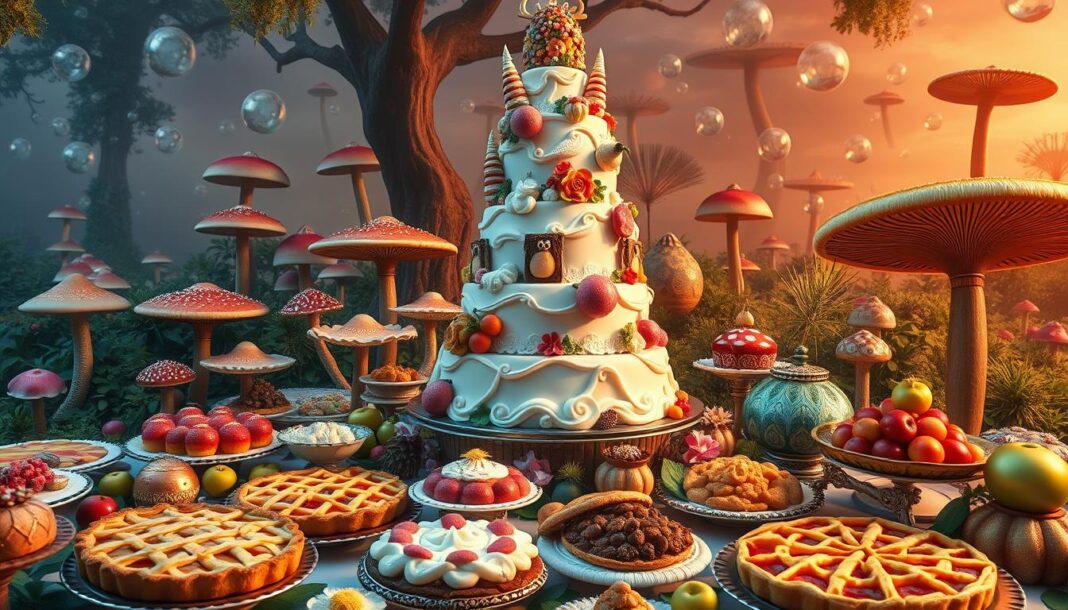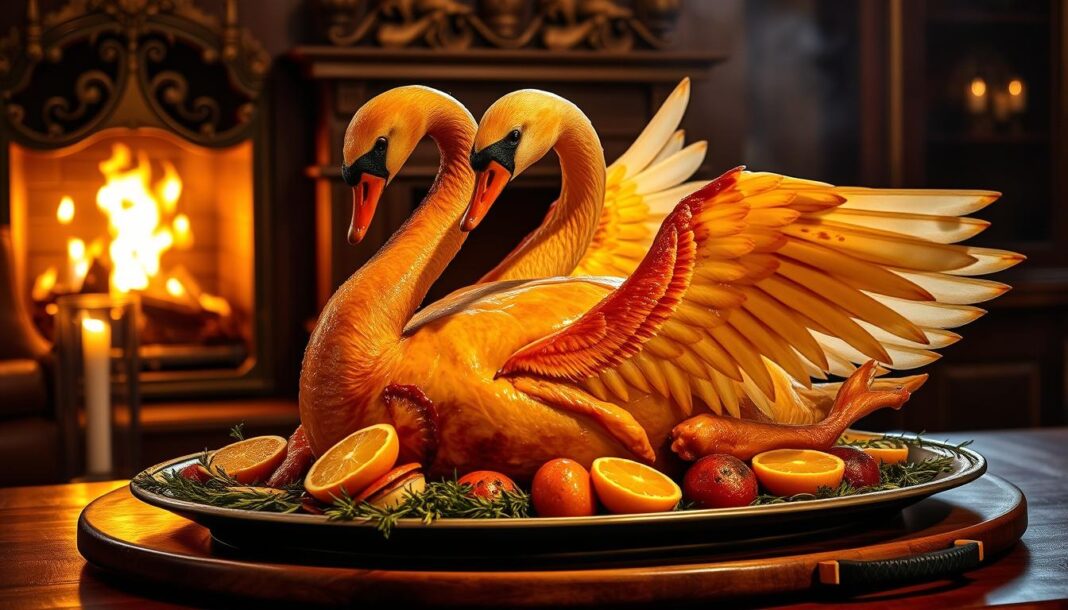Exploring the culinary practices of the past can be a fascinating journey, especially when it comes to dishes like tarts, which were a staple in many cuisines. During the Medieval period, cookbooks were scarce, but by examining the recipes from later periods, we can gain insight into the way people ate centuries before.
The art of making pastry has evolved significantly over time, with early crusts serving more as containers than as a culinary delight. Historical recipes reveal the ingredients, cooking methods, and taste preferences of people living in a different century. We will explore authentic recipes that have been adapted for the modern kitchen, maintaining their historical integrity.
Key Takeaways
- Understanding historical culinary practices provides insight into the evolution of food traditions.
- Medieval tarts often blurred the line between sweet and savory flavors.
- Pastry techniques have significantly evolved over time.
- Historical recipes offer a glimpse into the ingredients and cooking methods of the past.
- Adapting historical recipes for the modern kitchen can be a rewarding culinary experience.
The Culinary World of Medieval Tarts
In medieval times, tarts were not just a food item but an experience, often serving as centerpieces at feasts. As we explore the culinary world of medieval tarts, it becomes evident that these dishes were more than just a part of the meal; they were a spectacle. The art of creating tarts was highly valued, with elaborate designs and presentations that reflected the host’s wealth and status.

Blurring the Line Between Sweet and Savory
Medieval tarts were incredibly versatile, with fillings that ranged from sweet ingredients like fruits and nuts to savory elements such as meats and cheeses. This versatility meant that tarts could be served at various stages of a meal, from appetizers to desserts. The ability to blur the line between sweet and savory was a hallmark of medieval culinary creativity, allowing cooks to experiment with a wide range of flavors and ingredients.
As was standard for cookbooks of the period, there were instructions not only for individual recipes but also for feasts and table designs, making them a comprehensive guide for cooks in rich households. Tarts were a significant part of these feasts, often serving as impressive centerpieces.
The Role of Tarts in Medieval Feasting
Tarts played a significant role in medieval feasting, particularly among the wealthy, where they were often used as impressive centerpieces at banquets. The visual presentation of tarts was considered an important aspect of their appeal, with elaborate decorations and designs. For special occasions, tarts might be constructed in multiple layers or decorated with edible gold leaf, heraldic designs, or other ornate elements.
The role of tarts in medieval feasting was not limited to the aristocracy; simpler versions were enjoyed across all social classes during this period. The art of making tarts was one of the marks of a skilled medieval cook, particularly in noble or royal households.
Authentic Medieval Pastry Techniques
Understanding medieval pastry techniques is crucial for recreating the flavors and textures of historical tarts. Medieval pastry was a fundamental component of cooking, serving as the base for both sweet and savory dishes.

Understanding “Cofyns” – The Medieval Pastry Case
In medieval cooking, pastry cases were referred to as “cofyns.” These were essentially containers made from pastry dough to hold various fillings. The term “cofyne” or “coffin” was used to describe the pastry crust that encased the filling, which was often made from simple flour and water.
Paest Royall vs. Simple Flour and Water
Medieval recipes sometimes called for “Paest Royall,” a more refined and enriched pastry dough, while at other times, a simple mixture of flour and water was used. The choice between these two types of pastry depended on the desired texture and the filling’s characteristics.
Recipe: Basic Medieval Tart Crust
To make a basic medieval tart crust, you will need 3 cups of all-purpose flour, 1.5 cups of very cold butter, 1/4 cup of sugar, 1 tablespoon of salt, and a scant cup of ice-cold water. Combine the dry ingredients, then mash in the cold butter until you have a crumbly mixture. This crust recipe yields a more buttery and palatable version that maintains historical integrity while being adaptable for various medieval tart fillings.
Our adapted recipe balances historical accuracy with modern tastes, creating a versatile dough that works well for both sweet and savory medieval fillings. By keeping ingredients cold and handling the dough minimally, you can achieve a desirable texture.
Sweet Medieval Tarts to Try at Home
Medieval sweet tarts offer a fascinating glimpse into the culinary practices of the past, blending flavors and techniques that still captivate us today. These desserts were not only a staple in noble households but also showcased the artistry and creativity of medieval bakers.
Marzipan Torte – A Noble Family Treat
Marzipan, a confection made from ground almonds and sugar, was a prized ingredient in medieval baking. The marzipan torte, in particular, was a favorite among noble families due to its rich flavor and luxurious texture.
Ingredients and Historical Context
The primary ingredients in a traditional marzipan torte include ground almonds, sugar, and egg whites. Historically, marzipan was shaped into various forms, often decorative, to be served at special occasions.
Preparation Method
To prepare a marzipan torte, begin by grinding almonds into a fine paste, then mix with sugar and egg whites until a dough forms. Shape the dough into desired forms and allow to set before serving. This process requires patience, as the marzipan needs time to firm up.
Peach and Cherry Tart with Red Wine
This tart combines the sweetness of peaches and cherries with the depth of red wine, creating a complex and satisfying dessert. The use of red wine in cooking fruit was a common practice in medieval cuisine.
Ingredients and Historical Context
The ingredients include peaches, cherries, red wine, sugar, cinnamon, and ginger. The combination of fruit and wine was typical in medieval desserts, where the wine added a rich, fruity flavor to the dish.
Preparation Method
- Begin by blanching peaches and cherries in boiling water for about two minutes to soften them slightly.
- Drain and cool the fruit, then arrange it in a prepared tart shell.
- Make a syrup by boiling equal parts red wine and sugar with cinnamon and ginger, stirring often, until it thickens after about 10-15 minutes.
- Pour the syrup over the fruit and cover with a top crust if desired.
- Bake at 375°F for approximately 60 minutes, or until the crust is golden and the filling is bubbling.
This tart is best served after cooling, allowing the flavors to meld together. The process takes some time, but the result is well worth the effort, yielding a dessert that’s both flavorful and visually appealing.
Savory Medieval Tarts Through the Ages
As we journey through the ages, we discover the rich flavors of savory medieval tarts. These culinary delights not only satisfied the palate but also reflected the social and cultural contexts of their time.
Apple and Gruyere Tart – A 16th Century Delight
The combination of apples and Gruyere cheese in a tart was a hallmark of 16th-century cuisine, showcasing the era’s penchant for blending sweet and savory flavors.
Ingredients and Historical Context
This tart features a filling made with apples, Gruyere cheese, and spices, all encased in a medieval-style pastry crust. The use of Gruyere indicates a level of culinary sophistication and access to imported goods.
- Apples provided natural sweetness and texture.
- Gruyere cheese added a rich, savory element.
- Spices like cinnamon and nutmeg were used to enhance flavor.
Preparation Method
To prepare this tart, start by making the medieval-style pastry crust. Then, fill it with a mixture of sautéed apples, Gruyere cheese, and spices. Bake until the crust is golden and the filling is set.
Onion Tart – The Medieval Quiche
Onion tart, akin to a medieval quiche, was a staple in many medieval households, offering a hearty and flavorful dish that could be served at various meals.
Ingredients and Historical Context
The primary ingredients include onions, eggs, and cheese, all of which were staples in medieval cuisine. The use of saffron for coloring and flavoring was also common among the wealthy.
We use both green and yellow onions, sautéing them in butter until they wilt, then cooling them before adding to the tart shell along with cheese and a saffron-infused egg mixture.
To make the onion tart, sauté the onions in butter for about one minute until they start to wilt. Then, mix beaten eggs with saffron (or turmeric for color), and pour this mixture over the cooled onions and cheese in the tart shell. Bake at 350°F for approximately 60 minutes, or until the filling is set.
- Sauté onions briefly to preserve their texture and flavor.
- Cool the onions before adding them to the tart to prevent premature cooking of the eggs.
- Use a combination of green and yellow onions for a complex flavor profile.
Bringing Medieval Flavors to the Modern Table
Medieval tarts offer a unique window into the past, revealing the flavors and techniques that shaped European cuisine. While the earliest fruit tarts emerged in the late Middle Ages, they were initially more likely to contain meat, vegetables, or cheese. As we adapt these historical recipes for today’s kitchens, we must balance traditional flavors with modern tastes.
The evolution of pastry techniques has transformed medieval tarts into the pie and tarts we enjoy today. Using ingredients like butter, water, and eggs, medieval cooks created crusts that were both functional and flavorful. By understanding the historical context of these recipes, we gain insights into the culinary traditions that have shaped our modern cooking techniques.
As we bring medieval flavors to the modern table, we discover that many of the fundamental techniques and flavor principles remain relevant today. The practical wisdom of medieval cooks continues to inspire contemporary cooking, making their recipes a valuable resource for cooks of all levels. At the bottom of it all, the love for good food and good pastry remains a timeless thing that transcends time.


